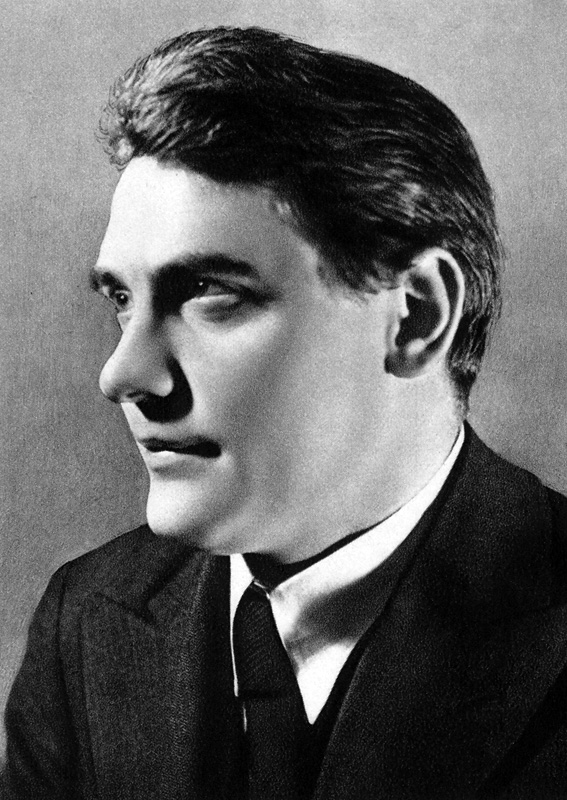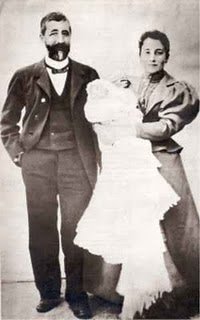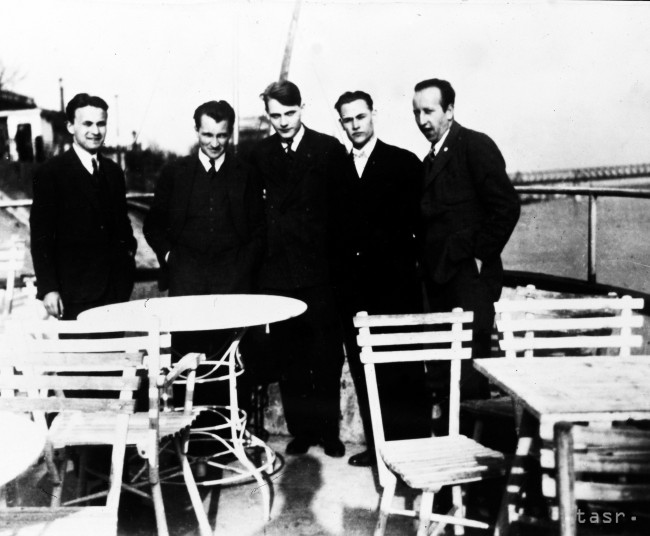|
Laco Novomeský
Laco Novomeský (full name: Ladislav Novomeský) (27 December 1904, Budapest – 4 September 1976, Bratislava) was a Slovak poet, writer and communist politician. Novomeský was a member of the DAV group; after The Second World War he was commissioner of education and culture of Socialist Czechoslovakia. A prominent Czechoslovak politician, he was persecuted in the 1950s and later rehabilitated in the 1960s. Early life Novomeský was born in to the family of a tailor that immigrated from Senica to Budapest, where he was born. The family moved back to Senica to continue his studies. He later graduated from the teacher training institute in Modra. Novomeský started to work as a teacher while at the same time enrolling as an external student of the Faculty of Arts at the Comenius University where he became involved in literary and political activities. Literary and political career He joined the Communist Party of Czechoslovakia in 1925 and worked for its press. He was the ed ... [...More Info...] [...Related Items...] OR: [Wikipedia] [Google] [Baidu] |
Portrait Novomesky-laco
A portrait is a painting, photograph, sculpture, or other artistic representation of a person, in which the face is always predominant. In arts, a portrait may be represented as half body and even full body. If the subject in full body better represents personality and mood, this type of presentation may be chosen. The intent is to display the likeness, personality, and even the mood of the person. For this reason, in photography a portrait is generally not a snapshot, but a composed image of a person in a still position. A portrait often shows a person looking directly at the painter or photographer, to most successfully engage the subject with the viewer, but portrait may be represented as a profile (from aside) and 3/4. History Prehistorical portraiture Plastered human skulls were reconstructed human skulls that were made in the ancient Levant between 9000 and 6000 BC in the Pre-Pottery Neolithic B period. They represent some of the oldest forms of art in the Middle East ... [...More Info...] [...Related Items...] OR: [Wikipedia] [Google] [Baidu] |
Slovaks
The Slovaks ( (historical Sloveni ), singular: ''Slovák'' (historical: ''Sloven'' ), feminine: ''Slovenka'' , plural: ''Slovenky'') are a West Slavic ethnic group and nation native to Slovakia who share a common ancestry, culture, history and speak the Slovak language. In Slovakia, 4.4 million are ethnic Slovaks of 5.4 million total population. There are Slovak minorities in many neighboring countries including Austria, Croatia, Czech Republic, Hungary, Poland, Romania, Serbia and Ukraine and sizeable populations of immigrants and their descendants in Australia, Canada, France, Germany, United Kingdom and the United States among others, which are collectively referred to as the Slovak diaspora. Name The name ''Slovak'' is derived from ''*Slověninъ'', plural ''*Slověně'', the old name of the Slavs ( Proglas, around 863). The original stem has been preserved in all Slovak words except the masculine noun; the feminine noun is ''Slovenka'', the adjective is ''slovensk ... [...More Info...] [...Related Items...] OR: [Wikipedia] [Google] [Baidu] |
International Brigades
The International Brigades () were soldiers recruited and organized by the Communist International to assist the Popular Front (Spain), Popular Front government of the Second Spanish Republic during the Spanish Civil War. The International Brigades existed for two years, from 1936 until 1938. It is estimated that during the entire war, there were some 32,000 Brigaders. Beyond the Spanish Civil War, "International Brigades" is also sometimes used interchangeably with the term List of foreign volunteers, foreign legion in reference to military units comprising foreigners who volunteer to fight in the military of another state, often in times of war. The headquarters of the brigade was located at the Gran Hotel, Albacete, Castilla-La Mancha. They participated in the battles of Battle of Madrid, Madrid, Battle of Jarama, Jarama, Battle of Guadalajara, Guadalajara, Battle of Brunete, Brunete, Battle of Belchite (1937), Belchite, Battle of Teruel, Teruel, Aragon Offensive, Aragon and ... [...More Info...] [...Related Items...] OR: [Wikipedia] [Google] [Baidu] |
Francisco Franco
Francisco Franco Bahamonde (born Francisco Paulino Hermenegildo Teódulo Franco Bahamonde; 4 December 1892 – 20 November 1975) was a Spanish general and dictator who led the Nationalist faction (Spanish Civil War), Nationalist forces in overthrowing the Second Spanish Republic during the Spanish Civil War and thereafter ruled over Spain from 1939 to 1975, assuming the title ''Caudillo''. This period in Spanish history, from the Nationalist victory to Franco's death, is commonly known as Francoist Spain or as the Francoist dictatorship. Born in Ferrol, Spain, Ferrol, Galicia, into an upper-class military family, Franco served in the Spanish Army as a cadet in the Toledo Infantry Academy from 1907 to 1910. While serving in Spanish protectorate in Morocco, Morocco, he rose through the ranks to become a brigadier general in 1926 at age 33. Two years later, Franco became the director of the General Military Academy in Zaragoza. As a Conservatism, conservative and Monarchism, ... [...More Info...] [...Related Items...] OR: [Wikipedia] [Google] [Baidu] |
Spanish Civil War
The Spanish Civil War () was a military conflict fought from 1936 to 1939 between the Republican faction (Spanish Civil War), Republicans and the Nationalist faction (Spanish Civil War), Nationalists. Republicans were loyal to the Left-wing politics, left-leaning Popular Front (Spain), Popular Front government of the Second Spanish Republic. The opposing Nationalists were an alliance of Falangism, Falangists, monarchists, conservatives, and Traditionalism (Spain), traditionalists led by a National Defense Junta, military junta among whom General Francisco Franco quickly achieved a preponderant role. Due to the international Interwar period#Great Depression, political climate at the time, the war was variously viewed as class struggle, a War of religion, religious struggle, or a struggle between dictatorship and Republicanism, republican democracy, between revolution and counterrevolution, or between fascism and communism. The Nationalists won the war, which ended in early 1939, ... [...More Info...] [...Related Items...] OR: [Wikipedia] [Google] [Baidu] |
Klement Gottwald
Klement Gottwald (; 23 November 1896 – 14 March 1953) was a Czech communist politician, who was the leader of the Communist Party of Czechoslovakia from 1929 until his death in 1953 – titled as general secretary until 1945 and as chairman from 1945 to 1953. He was the first leader of Communist Czechoslovakia from 1948 to 1953. Following the collapse of democratic Czechoslovakia after the Munich Agreement, the right-wing leadership of the Czechoslovak Second Republic banned the Communist Party, forcing Gottwald to emigrate to the Soviet Union in November 1938. In 1943, Gottwald agreed with representatives of the Czechoslovak-government-in-exile located in London, along with President Edvard Beneš, to unify domestic and foreign anti-fascist resistance and form the National Front. He was the 14th prime minister of Czechoslovakia from July 1946 until June 1948, the first Communist to hold the post. In June 1948, he was elected as Czechoslovakia's first Communist president, ... [...More Info...] [...Related Items...] OR: [Wikipedia] [Google] [Baidu] |
Manifesto Of The Seven
The Manifesto of the Seven () was a protest by seven artists against the Bolshevization of the Communist Party of Czechoslovakia (KSČ), after its 5th Congress in 1929. The text was written on the initiative of Ivan OlbrachtLexicon of Czech Literature 3 / I. Prague: Academia, 2000, pp. 664–671. and was published as a leaflet entitled ''Communist writers to communist workers''. It called for the removal of the new Gottwaldova party leadership, which, in the opinion of the signatories, threatened the mass character and ability to act of the Communist Party. History In 1921, the Communist Party of Czechoslovakia (KSČ) was founded. In 1925, the party decided to carry out a process of Bolshevization, it wanted to leave the course that had been relatively libertarian up to that point and to instead adopt the politics of the Comintern. The change of course was sealed by the election of Klement Gottwald as party leader at the 5th party congress in February 1929. Among other things, t ... [...More Info...] [...Related Items...] OR: [Wikipedia] [Google] [Baidu] |
Slovak National Uprising
Slovak National Uprising ( Slovak: ''Slovenské národné povstanie'', abbreviated SNP; alternatively also ''Povstanie roku 1944'', English: ''The Uprising of 1944'') was organised by the Slovak resistance during the Second World War, directed against the German invasion of Slovakia by the German military, which began on 29 August 1944, and on the other against the Slovak collaborationist regime of the Ludaks under Jozef Tiso. Along with the Warsaw Uprising, it was the largest uprising against Nazism and its allies in Europe. Carried by parts of the Slovak army, the main area of the uprising was in central Slovakia, with the town of Banská Bystrica as its centre. The Slovak insurgent army (officially the 1st Czechoslovak Army in Slovakia) was under the overall command of a military headquarters of the opposition Slovak National Council. This represented a coalition of the civic Democratic Party and the Slovak communists and was linked to the Czechoslovak government-in-exile ... [...More Info...] [...Related Items...] OR: [Wikipedia] [Google] [Baidu] |
Vladimír Clementis
Vladimír "Vlado" Clementis (20 September 1902 – 3 December 1952) was a Slovak politician, lawyer, publicist, literary critic, author and a prominent member of the Czechoslovak Communist Party. Between 1948 and 1950, he served as Minister of Foreign Affairs of Czechoslovakia. In 1952, he was accused of "Titoism" and "national deviation" during the Slánský trial and executed. Biography After attending gymnasium in Skalica, Clementis studied in Germany and France before graduating with a Ph.D. from the Faculty of Law of Charles University in Prague. During his studies, he took an interest in the philosophy of Emanuel Rádl, František Krejčí and Vilém Forster. He also served as co-editor of '' Dav'', a cultural and political journal that had broad influence in inter-war Czechoslovakia, particularly among Slovaks. As editor of ''Dav'', Clementis published works by writers such as Martin Rázus, Milo Urban, Ján Smrek, Gejza Vámoš and T. Gašpar. In addition, togethe ... [...More Info...] [...Related Items...] OR: [Wikipedia] [Google] [Baidu] |
Gustáv Husák
Gustáv Husák ( , ; ; 10 January 1913 – 18 November 1991) was a Czechoslovak politician who served as the long-time First Secretary of the Communist Party of Czechoslovakia from 1969 to 1987 and the President of Czechoslovakia from 1975 to 1989. His rule is known for the period of normalization after the 1968 Prague Spring. Early life Gustáv Husák was born to an unemployed worker in Pozsonyhidegkút, Kingdom of Hungary, Austria-Hungary (now Bratislava- Dúbravka, Slovakia). He joined the Communist Youth Union at the age of sixteen while studying at the grammar school in Bratislava. In 1933, when he started his studies at the law faculty of the Comenius University in Bratislava, he joined the Communist Party of Czechoslovakia (KSČ) which was banned from 1938 to 1945. During World War II, he was periodically jailed by the Jozef Tiso government for illegal Communist activities. He was one of the leaders of the 1944 Slovak National Uprising against Nazi Germany and T ... [...More Info...] [...Related Items...] OR: [Wikipedia] [Google] [Baidu] |
Andrej Sirácky
Andrej Sirácky (9 December 1900 – 29 September 1988) was a Slovak sociologist, philosopher, political scientist and communist official. Biography After graduating from the grammar school in Vrbas in 1921, he applied to study philosophy at Charles University in Prague, which he finished with a doctorate in 1926. During his studies in Prague, he met Slovak left-wing intellectuals and students and became a founding member of the ''DAV'' group. After completing his studies, he returned home to Petrovac in Vojvodina, where he taught with a break at the Slovak gymnasium until 1941. He participated in the Slovak resistance during World War II and was imprisoned in Budapest. After his release, he briefly worked as an editor of the journal ''Slovenská jednota''. In August 1948, he moved to Slovakia, where he began working at Comenius University and from 1953 to 1955 he was its rector. Sirácky was also chairman of the Slovak Academy of Sciences from 1955 to 1961. He successively obta ... [...More Info...] [...Related Items...] OR: [Wikipedia] [Google] [Baidu] |
Eduard Urx
Eduard Vincenc Urx (29 January 1903 – 20 April 1942) was a Czechoslovak communist politician, journalist, essayist, literary critic and theorist. A member of the anti-fascist resistance movement, he was captured and murdered by the Nazis during the occupation. Biography Urx was born in 1903 in Velká nad Veličkou, into the family of a forestry official. He was baptized a Catholic but the left the Church in 1924. From 1922 to 1925 he studied philosophy and Czech and German philology at Charles University, but did not finish his studies and became a member of the Free Association of Socialist Students from Slovakia. He joined the Communist Party of Czechoslovakia (KSČ) in 1924. He was involved in the founding of the '' DAV'' magazine. Due to theoretical disagreement he left the group with Peter Jilemnický. Urx was engaged in journalistic and propaganda. Urx was a close associate of Klement Gottwald and supported his new leadership. From 1929 to 1931 and 1938, Urx was the edit ... [...More Info...] [...Related Items...] OR: [Wikipedia] [Google] [Baidu] |







